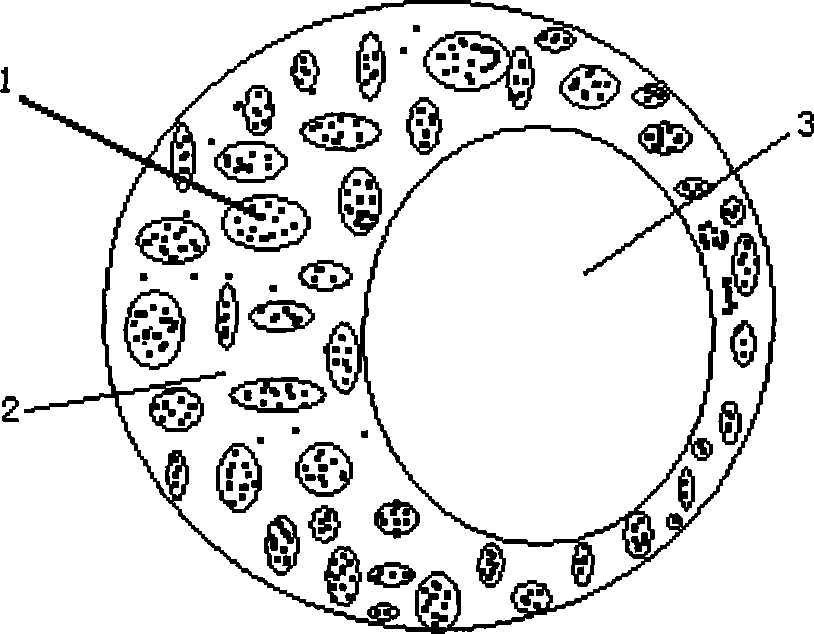Method for producing conducting fiber
A manufacturing method and technology for conductive fibers, which are applied in the manufacturing of conductive/antistatic filaments, melt spinning, and conjugated synthetic polymer rayon, etc., can solve the problem of low production rate, poor post-processing performance, and manufacturing costs. Increase and other problems, to achieve the effect of good electrical conductivity and good wear resistance
- Summary
- Abstract
- Description
- Claims
- Application Information
AI Technical Summary
Problems solved by technology
Method used
Image
Examples
Embodiment 1
[0029] Polypropylene containing 30% conductive carbon black and dry polyamide-6 are blended at a weight ratio of 2:3 under the action of 0.5% silane coupling agent to make a sea-island type conductive high polymer. Then the sea-island type conductive high polymer and polyamide-6 are dried separately, and spun by a two-component composite spinning machine to obtain the sea-island type conductive high polymer as the skin layer component, and polyamide-6 as the sheath core of the core layer component type composite conductive fibers. The ratio of the skin component to the core component is 1:1, and the breaking strength of the 22dtex / 3f conductive fiber is 3.5CN / dtex, the breaking elongation is 25.8%, and the electrical resistance is 3.5×10 -6 Ω / cm.
Embodiment 2
[0031] Polyethylene containing 30% conductive carbon black and dry polyamide-6 are blended at a weight ratio of 2:3 under the action of 0.5% silane coupling agent to make a sea-island type conductive high polymer. Then, the sea-island type conductive high polymer and polyamide-6 are dried separately, and spun by a two-component composite spinning machine to obtain a skin layer in which the sea-island type conductive high polymer is the skin layer component and polyamide-6 is the core layer component. Core type composite conductive fiber. The ratio of the skin component to the core component is 1.5:1, and the breaking strength of the 22dtex / 3f conductive fiber is 3.1CN / dtex, the breaking elongation is 28.0%, and the electrical resistance is 5.2×10 -6 Ω / cm.
Embodiment 3
[0033] Polypropylene containing 30% conductive carbon black and dry polyester are blended in a weight ratio of 1:3 under the action of 0.5% silane coupling agent to make a sea-island type conductive polymer. Then, the sea-island type conductive high polymer and the separately dried polyethylene terephthalate are spun by a two-component composite spinning machine to prepare the sea-island type conductive high polymer as a trilobal composite conductive fiber. The ratio of the sea-island type conductive high polymer component to the polyethylene terephthalate component is 1:4, and the breaking strength of the 22dtex / 3f conductive fiber is 3.5CN / dtex, and the breaking elongation is 32.0 %, the resistance is 4.2×10 -7 Ω / cm.
PUM
| Property | Measurement | Unit |
|---|---|---|
| elongation at break | aaaaa | aaaaa |
| elongation at break | aaaaa | aaaaa |
| elongation at break | aaaaa | aaaaa |
Abstract
Description
Claims
Application Information
 Login to View More
Login to View More - Generate Ideas
- Intellectual Property
- Life Sciences
- Materials
- Tech Scout
- Unparalleled Data Quality
- Higher Quality Content
- 60% Fewer Hallucinations
Browse by: Latest US Patents, China's latest patents, Technical Efficacy Thesaurus, Application Domain, Technology Topic, Popular Technical Reports.
© 2025 PatSnap. All rights reserved.Legal|Privacy policy|Modern Slavery Act Transparency Statement|Sitemap|About US| Contact US: help@patsnap.com



